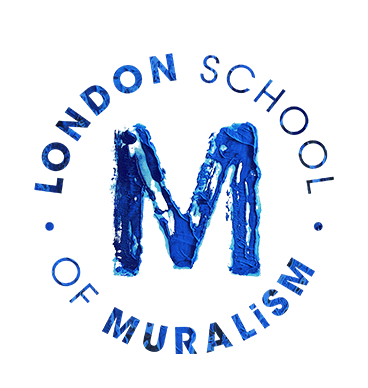Applications Now Open
2026 Muralism Course
Next Course
2026 Participatory Muralism Course
The London School of Muralism is thrilled to announce its 6th course, scheduled to run from January to May 2026, spanning twenty weeks. This course will delve deep into the realm of self-initiated, artist-led community murals, prioritizing group creative expression over individual, unilateral or commercial endeavors.
Our emphasis will be on fostering creative collaboration—empowering participants to co-create mural concepts while guiding the artistic and production processes from inception to completion. Throughout the five-month duration, students will explore all facets of mural conception and execution, culminating in the creation of their participatory murals and contributions to a large-scale mural led by LSoM and Artmongers founder Patricio Forrester.
As part of the course, each student will undertake the production of their own individually led, participatory mural—a form of action research. They will integrate newfound knowledge as the course progresses, while also engaging in exploration and experimentation under the mentorship of school tutors.
This immersive educational journey promises a blend of enjoyable experiences, challenging scenarios, and in-depth exploration of the intricacies involved in crafting murals for public spaces.
The London School of Muralism is an independently run programme set up by Artmongers Action CIC and it will take place mainly at Goldsmiths Deptford Town Hall, in New Cross, South East London.
2026 Course Fees: Part time £890 Full Time £990
To Apply:
A) Stage 1 Application: complete this form
B) We'd like to meet you for a practical creative session. You can get a feel if the course is a good fit for you and vice versa6
C) If this goes well, we'll invite you to submit a Stage 2 application .
In order for us to make you an unconditional offer for a place, you would need to have secured permission to paint a public facing wall from its owner. We will make a conditional offer if you haven't got a wall when you apply.
Here is an outline of what to expect from the stage 2 application:
- A 500 word statement on why you'd like to join the course.
- Submit up to six relevant images of your artistic practice.
- Share a photo & details of a wall you have secured permission to paint as part of the course.*
Part-time = Wednesdays, Full-time = Wednesdays & Saturdays
Course Structure:
Term 1 Introduction to Muralism and Participation.
Four perspectives on participatory muralism via specific cases delivered by 4 different lead artists. From general ideas to workshop planning, delivering them and transforming received material from participants into one mural sketch.
Term 2 Student Led Participatory Mural.
Understanding context and participants capacities, plan and design 3 participatory workshops with focus on image making and scoping in response to each workshop's findings. Transform ideas and sketches into a paintable sketch. Preparation for signing off, negotiating and reworking.
Painting Logistics, risk assessment and production
Evaluating the results.
Term 3 School Led Participatory Mural
Artmongers (Patricio) will be leading two participatory mural processes involving students as participants as well as external participants. One will be in Deptford Market and involve market stall holders and the other in HMP Downview, a women’s prison in Sutton. Having run your own project, you will be in a good position to observe and learn through action research.
Course dates: Sat 10th January to Wednesday 10th of June 2026
Break 1 February Half Term, Break 2 : Easter April, End of Course Celebration: Weds 3rd June. Tatal = 5 months / 18 weeks. Part-time = Wednesdays, Full-time = Weds & Sats.
Overview:
Introduction to Participatory muralism, urban landscape and architectural context.
Crucial differences between muralism and street art
Why participation is the way of the future art practice
Generating Ideas and Workshop Progression:
Developing creative concepts and sketches.
Planning workshops with a focus on copyleft processes.
Further exploration of innovative ideas and angles.
Ongoing development of sketches.
Turning a simple sketch into a fully developed paintable proposal
Scaling Up:
Understanding the Doodle Grid technique for enlarging images and adapting them to fit the final location and scale.
Risk Assessment, Logistics
In-depth exploration of risk assessment and method statements for safety.
Managing production logistics for effective mural creation.
Preparation and Collaboration:
Ensuring safety protocols and best practices when working at elevated heights.
Preparing the mural site for the artwork installation.
Securing a painting wall, including potential collaboration with fellow students.
Community Engagement and Public Support:
Artistic responsibility within a team. Identifying Participants and Stakeholders
Exploring community engagement methodologies
Navigating legal aspects such as council regulations, permissions, and risk assessments.
Participatory Process and Consensus Building:
Balancing the politics of public art.
Exploring ideas and themes for community engagement.
Evaluating Process
Design development processes, considering time constraints.
Execution and Implementation:
Budgeting for mural projects.
Creating realistic timelines.
Planning and estimating quantities of materials and equipment.
Addressing health and safety concerns, including safeguarding.
Building a supportive team.
On-Site Mural Painting Skills:
Scaling up artwork and integrating it with the chosen wall.
Constructing scaffolding towers.
Defining specific mural areas.
Managing volunteers and adapting to their skill levels.
Balancing rest times and project progression.
Recognizing when adjustments are needed and when to conclude work.
Varnishing and implementing anti-graffiti measures.




